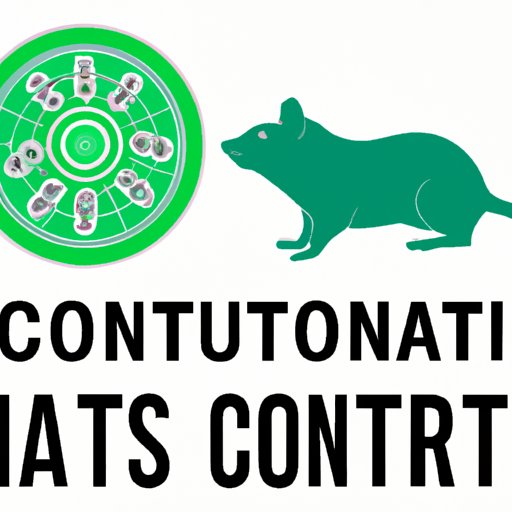
Introduction
Animal control services are essential for ensuring the safety of both pets and people. Whether it’s responding to reports of loose animals or investigating cases of animal cruelty, animal control officers play a crucial role in protecting the welfare of animals and humans alike.
Although many people assume that animal control services are free, the reality is that these programs are funded by taxpayer dollars and require significant resources to maintain. In this article, we will explore the costs of animal control services, the benefits they provide, and strategies for making animal control more affordable.
Dispelling the Myth: Why Animal Control is Not Free
One of the most common misconceptions about animal control services is that they are provided free of charge. In reality, animal control programs are funded by tax dollars and require significant resources to operate.
Animal control officers must have specialized training and equipment to properly handle and care for animals. They also need to have access to proper facilities for housing and caring for animals who have been seized or surrendered.
Animal Control Fees: Understanding the Costs
Animal control fees typically cover the costs associated with responding to reports of loose or aggressive animals, caring for stray or surrendered animals, investigating animal cruelty cases, and enforcing animal-related laws and ordinances.
These fees are determined based on the cost of providing these services, which can vary depending on several factors such as the size and population of a municipality, the number of animal control officers employed, and the range of services provided.
In general, animal control fees range from $50-$150 for basic services such as animal pickup and transportation. More complex services such as cruelty investigations can cost up to $500 or more.
Is Animal Control Worth the Price? A Cost vs. Benefit Analysis
Despite the costs associated with animal control services, there are many benefits to having a well-funded animal control program. Some of the key benefits include:
– Ensuring public safety: Loose or aggressive animals can pose a risk to public safety. Animal control officers play a crucial role in responding to reports of these animals and ensuring that they are properly contained and cared for.
– Protecting animal welfare: Stray or abandoned animals may be at risk of illness, injury, or death without proper care. Animal control officers work to ensure that these animals are provided with proper care and housing.
– Preventing animal cruelty: Animal control officers investigate reports of animal cruelty and work with law enforcement officials to prosecute offenders.
– Saving taxpayer money: By addressing issues related to animal control early on, animal control programs can prevent more costly problems from developing down the road.
Bridging the Gap: Making Animal Control More Affordable
Despite the benefits of animal control services, many people struggle to afford the fees associated with these programs. Fortunately, there are several strategies that can help to make animal control more affordable for everyone:
– Providing low-cost spay/neuter services: Spaying or neutering your pets can prevent them from contributing to the stray animal population and potentially requiring animal control services in the future.
– Offering payment plans: Many animal control programs offer payment plans for those who cannot afford to pay the full cost of services upfront.
– Partnering with local organizations: Animal control programs can partner with local humane societies or other animal welfare organizations to provide low-cost services to the community.
Covering the Cost: Options for Paying for Animal Control Services
Those who are unable to afford animal control fees may have several payment options available to them. Some of the most common payment options include:
– Paying upfront: This is the most straightforward payment option, where you pay the entire fee upfront.
– Payment plans: Many animal control programs offer payment plans for those who cannot afford to pay the full cost of services upfront.
– Low-cost options: Some animal control programs may offer low-cost services for those who meet certain income requirements.
Animal Control Funding: Where Does the Money Go?
Animal control services are typically funded by a combination of taxpayer dollars and fees collected from pet owners. These funds are used to cover the costs of animal control officers, facilities, equipment, and other necessary expenses.
In addition to providing basic animal control services, these funds may also be used to support programs aimed at promoting responsible pet ownership and preventing animal cruelty.
Protecting Your Pets: The Importance of Properly Funding Animal Control Programs
Properly funding animal control programs is essential for ensuring the safety and welfare of both pets and people. Without adequate funding, animal control programs may be unable to respond to reports of loose or aggressive animals or provide proper care for stray or surrendered animals.
Underfunded animal control programs may also be less effective at investigating cases of animal cruelty and enforcing animal-related laws and ordinances. This can have serious implications for both animals and humans alike.
Conclusion
In conclusion, animal control services are not free. These programs require significant resources to operate and are funded by tax dollars and fees collected from pet owners.
Despite the costs associated with animal control services, there are many benefits to having a well-funded program, including ensuring public safety, protecting animal welfare, and preventing animal cruelty. By understanding the costs associated with animal control services and the benefits they provide, we can work to support these programs and ensure that they are accessible to all members of our communities.




